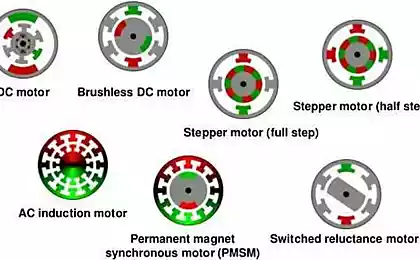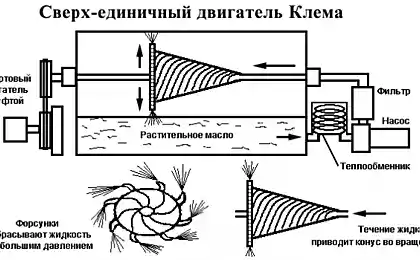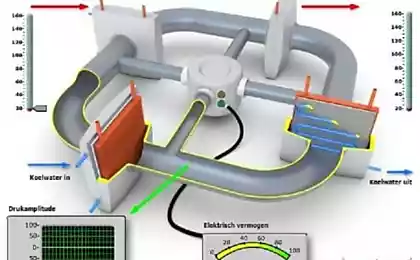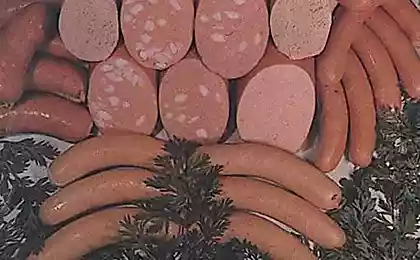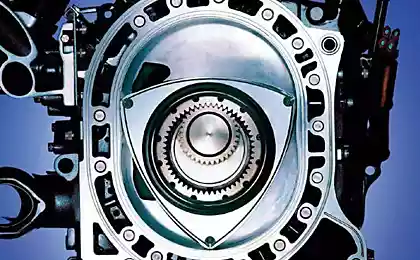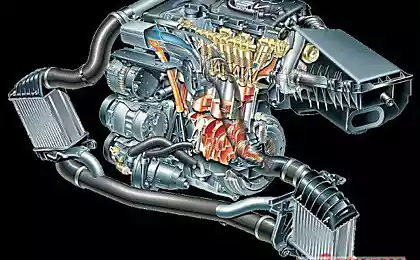1021
What can be found in sausage
Ordinary consumers to learn from what is actually made sausage, is not so simple. Since Soviet times, this issue has acquired a pile of rumors and speculation. © Author
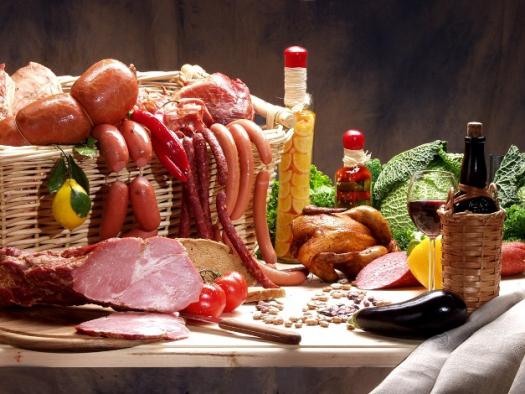
How do you know what the sausage to eat meat, you ask. And you will be absolutely right to do it oh how difficult. Cunning and dishonest manufacturers sometimes "hide" in sausages such as the consumer does not even realize. It is clear that after the toilet paper, which supposedly added to the Brezhnev era in the sausage and rats, which are constantly falling on the conveyor belt, it is difficult to have anything to frighten and discourage the use of these products. But believe me, the current miracles of food technologies allow for painless sausage producer to sell to consumers, which is not even a hint of meat. Even the magic word "meat" is claimed on the packaging, does not help.
Many companies use instead of meat so called MDM - a kind of substance, made from the bones with some meat. Under the pressure is converted into something similar to the sauce and use instead of meat. And on the package and they write: "Pork", "beef", etc. Instead of "turkey meat" is often used MDPM - like substance made from the bones of the turkey. This is a disaster comparable to soy. If the supplement is soybean still pointing in the composition as a vegetable protein, the MDM indicate meat. In Russia, it is not prohibited. In Europe, to avoid this, the manufacturers require on the package not only the composition but also the amount of meat, spice and other components. Unfortunately, these rules only work within the European Union, and supplying products in Russia, manufacturers are not required to specify it.
Furthermore, not every piece of meat in Europe considered meat. This is not a tautology. Meat cattle must contain no more than 25% fat and 25% connective tissue - veins, ligaments, cartilage. The fat pork can be 5% greater, and in poultry and rabbits less: fat - 15%, the connective tissue - up to 10%. All these rules spelled out in the relevant documents of the EU. They are introduced to ensure that consumers understand what it spends money and what to eat.

According inherited from the Soviet Union standard (GOST), sausage, "Doctor" should consist of 25% beef, 70% pork, 3% of the eggs and 2% milk. However, very few companies dare to make sausage for guests - expensive to obtain, or rather, less profit is the enterprise. Therefore, sausage makers develop their formulations, fix them in the technical specifications (TU) and kept in deep secret.
State Key Laboratory at the best sausages checked for safety components, but not on their quality. The state has no funds to monitor the safety of products, and the business itself is not interested in it. If these standards (GOST) take, it will be necessary to invest in the modernization, tighten quality - there is no money. So we have now is not quality but quantity is a priority.
Under the new standards in virtually all sausages banned any supplements.
Cooked sausage the premium should be 100% composed of meat.
Sausage first grade - 70% meat also allowed the presence of a protein stabilizer - 10%, soybean and dairy products - 10%, cereals - 5% starch - 5%.
Sausage second grade - 60% meat and 40% additives.
Smoked sausage premium - 100% meat. Not allowed the addition of flour and starch.
Smoked sausage first grade - 90% meat and 10% of wheat flour and soy products.
Spoiled meat or sausage meat processing plant is subjected to chemical reagents decontamination and recycling.
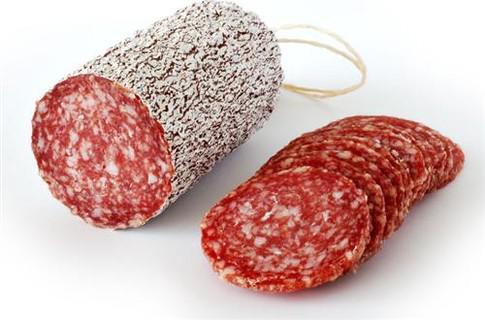
So what does actually make the sausage?
Sausages in the polymer shell:
45% - Emulsion
25% - soya protein.
15% - poultry meat.
7% - just meat.
5% - flour, starch.
3% - flavoring.
Wieners:
35% - Emulsion
30% - soya protein.
15% - just meat.
10% - poultry meat.
5% - flour / starch.
5% - flavoring.
Sausages:
Similarly, sausages, poultry, instead of just talking fepmentipovannaya pigskin, nytpyanoe substandard and subcutaneous fat.
Cooked sausage:
30% - poultry meat.
25% - Emulsion
25% - soya protein.
10% - just meat.
8% - flour / starch.
2% - flavoring.
Explanation:
Emulsion - skin sybppodykty waste myasoppoizvodstva - everything is ground up and yvapennoe to the state of the light-gray slurry.
Meat - Meat kps / MPC and pork. In the vast majority - the English bpiketipovannaya pork.
Flour / starch - kykypyznaya / potato flour and starch.
Flavors - thickeners, coloring, "the taste of meat", preservatives, salt,
sugar, pepper to vkysy. The most common way to replace meat in sausage - is to add soy protein instead. Soya - is an ordinary white powder. Mix it with water, and he turns to mush, which can salt the pepper, tint and added to sausage instead of meat.
The main property of soy protein - absorb water, swell and increase yield. The more water can absorb protein, the better it is. According to the degree of hydration (moisture absorption) soy protein is divided into three types: soy flour, soy isolate and soy concentrate. Now almost all the meat-packing plants have switched to concentrate, though it is more expensive, but it absorbs all the more water. Technologists meat processing, like the ancient alchemists, is constantly looking for all the soy protein with higher absorbency.
Choosing the sausage market, we always try to find one that is cheaper and more tasty (though somewhere deep down and guess that cheap and tasty - the concept of incompatible sausage). The main objective of manufacturers of sausages the same: to come up with a wonderful sausage - cheap and that everyone likes. Here it goes to the aid of the chemical industry and the wonders of food technology. And they come to us at the factory precisely with the West and, in particular, from the homeland of sausage - Germany.
For example, some companies use a curious German additive - carrot fiber. This fiber, as well as soybeans, has profitable for producers of sausage ability to absorb moisture. Its safely pour into sausage meat, pour the water and it swells, increasing several times the weight of the final product.
However, no color and smell of the fiber is not. And there was no harm in contrast to the genetically modified soybeans health shall not be: in fact, it is generally not absorbed by the body, but as its manufacturers claim, is necessary for the good performance of the large intestine. So even the manufacturer, on the contrary, the label boasts that its product "is enriched in dietary fiber." Abroad, for example, this very special fiber all add - in bread, ice cream, pasta, pastries, and even pet food, to make them more useful for health.
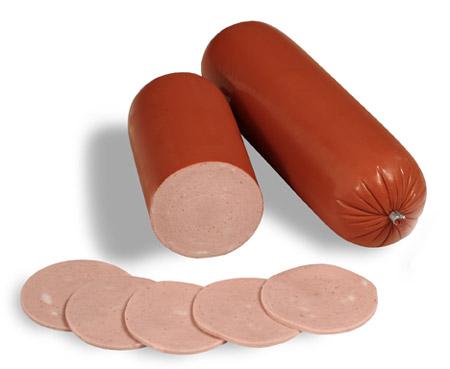
Even expensive delicacies - chop, ham, pork loin, etc. - Is not one hundred percent consist of meat, though there are as beef premium. To fool the buyer - to take more money and less meat to sell - in meat goodies ... add water. A piece of meat for a long time twist in a special vacuum processor with water, all the water is gradually meat absorbs a: it becomes harder and it seemed juicier. Another method - spraying. Simply put, ham make a lot of shots by injecting water into the muscle and spices. As a result, the piece becomes heavier more than twice! That water then flowed not from a piece back many advanced meat processing plants is injected into the meat is not just water, and its solution with gelatin or carrageenan.
Though it is necessary to take into account that, even if not stuffed sausage carrot chips, soy and hammer bones, the meat itself may be hazardous to health. Even if the sausage is written, that it is produced in Uryupinsk, in fact the meat for it could come from the other end of the world - pork from China, buyvolyatina from Argentina, kenguryatiny from Australia. What are they stuffed their animals intended for export to Russia is not known. As the sausages contain a lot of water and boiled sausages its content can reach 70%, then there is a large expanse of counterfeiters in the area. For increased water retention in these products they are usually administered water-binding ingredients: starch, gums, dextrins, inulin, and other polysaccharide complexes. It is established that the content sausage only 3-5% starch retains water at 20-25% higher than the impurity sausage without starch. Identify the contents of these complexes is simple: place a large slice of sausage with a solution of iodine. If you see a blue sausage, or the appearance of individual blue dots, it clearly indicates that the product is introduced starch.
For example, in a tent, kiosk, shop brought smoked sausages with a high water content. During storage in the refrigerator in the store part of the water evaporates and lot weight becomes smaller. In order not to incur losses, the seller before implementation using a syringe to introduce additional water into the loaf. To the buyer is not found, it sold only a loaf of sausage.
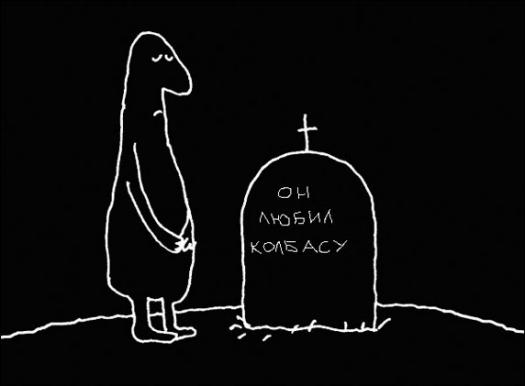
The shop brought fresh supposedly just a meat-packing plant, a warm sausage, whose weight is more than cooled down to room temperature condition. As a result of that seller cheated on a few kilos. He is forced to compensate for their mistakes at the expense of the buyer or the addition of water in a loaf or shortchange the customer.
The introduction of various coloring agents (magenta, beet juice, a special "sausage" dyes), currently rampant both abroad and in Russia. Many must have seen in his kitchen, that when boiled sausages or wieners in water, it is why it is colored in pink. This immediately suggests that before you fake.
Since sausages belong to your favorite canned products from meat, the stuffing (especially cheap varieties of sausage) usually is not only the meat of low grade, but even meat and organs damaged (starts to decompose), laced-WIDE parasites (eg, Finns, tapeworm ) which can not be sold openly because of their poor appearance and quality.
To extend the life of the sausages, especially cooked, they introduced a variety of antibiotics. This can significantly extend the shelf life of sausages especially sliced.
Convenient services shop - sliced sausage - actually a disservice to health. According to sanitary regulations, cutting machine must be kept meticulously clean. And the one that stands in a nearby supermarket, just a loaf of chopped boiled pork and smoked, but an hour ago - "Milk" economy class. Therefore, everything that was in these products (plus germs) got on your cuts. In addition, before the "butchering" sausage must be cleaned from the shell, but most sellers do not - and all the dirt that could settle on the shell (eg, hand-seller or the walls of the refrigerator) on a mandatory basis will move to your sandwich.
With the help of vacuum circuit packaging retail chains often give a "second life" cutting in which the deadline for storage.
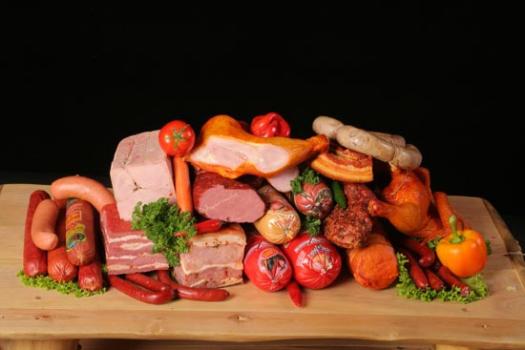
A few tips for choosing the sausages:
- If you buy carefully look at the packaging, labeling, date of manufacture and expiry date;
- Pay attention to the way the product is stored in a storefront window. The optimum temperature for storage of meat and sausages from 0 to 6 C;
- The surface of the sausage must be clean, dry and free from damage, punctures, sagging stuffing;
- Shell - artificial or natural - not to deviate from the product. This lack suggests that the sausage is likely to retain moisture due to improper storage, or simply old.
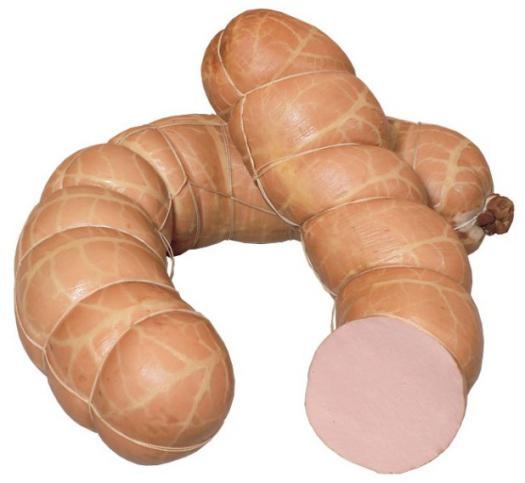
The main types of sausages:
Cooked sausages are made from salted meat. They are cooked at a temperature of about 80 degrees. Cooked sausages may contain large amounts of soy, and can be vegetarian with soy instead of meat or seytanom. Due to the large amount of water is not stored for a long time.
Composition: 10-15% protein, 20-30% fat.
Energy value per 100 g .: 220-310 kcal.
Cooked smoked sausages are cooked first, and then subjected to smoking. They contain more spices than cooked sausages. Unlike the cooked sausage (stuffing which is a solid mass) of cooked sausages can consist of small pieces of a certain size. The additives used milk, cream, flour, fat and starch. Shelf life in the refrigerator for 2 weeks.
Composition: 10-17% protein, 30-40% fat.
Energy value per 100 g .: 350-410 kcal.
Smoked (tverdokopchenye) sausage is not subjected to heat treatment, cold smoking occurs at 20-25 degrees, the meat is fermented and dehydrated. Maturing of raw sausages takes at least 30-40 days. Smoked sausages contain the greatest amount of spices, it is also possible to add the cognac.
Composition: 13-28% protein, 28-57% fat.
Energy value per 100 g .: 340-570 kcal.
Jerked sausages are made from meats of the highest quality as a result of prolonged drying, no smoking. In minced spices are added, as well as honey and brandy.
If the manufacturer uses the fresh meat in the composition of such products, then add it flavors and flavor enhancers do not have special needs, well, except that of the economy. But if the product is made of stale meat, then it can hide not only the chemical additives, but and soy isolate. Cosi especially old meat that has been frozen, for example, in the manufacture of a pretty loin, bacon, which are made of whole meat. Check this product can usually suspiciously cheap price and a list of ingredients.
Also, there is a perception that if the sausage and meat products are a bright pink color, they are more recent. It's not the color they give a variety of dyes, nitrites, and all sorts of additives. This is not the safest supplements, but manufacturers have traditionally used them in small doses, in order to attract consumers. Far better sausage and meat products grayish color - this is the natural color of the meat after processing.
But to give up meat products can not, because they are the best source of some essential amino acids, iron and B vitamins such as iron is very difficult to obtain in sufficient amounts from plant foods. It is considered that a good source of iron are apples, buckwheat and grenades, but it is not such a substance from plant foods is very poorly absorbed.
Nutritionists advise eating foods from meat not with potatoes, pasta and cereals, as is customary with us, and with any vegetables - steamed, fried, boiled, steamed, salad and herbs. This combination of products optimally, not only in terms of healthy eating, but also from the standpoint of classical medicine.
p-i-f.livejournal.com
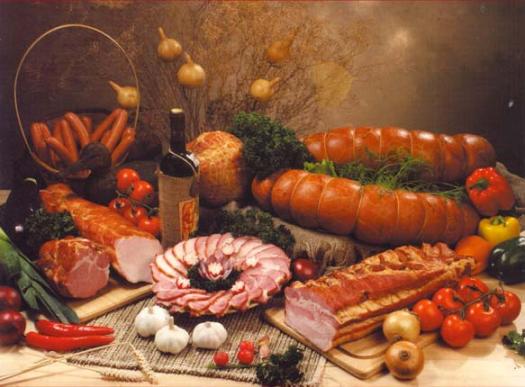
Source:

How do you know what the sausage to eat meat, you ask. And you will be absolutely right to do it oh how difficult. Cunning and dishonest manufacturers sometimes "hide" in sausages such as the consumer does not even realize. It is clear that after the toilet paper, which supposedly added to the Brezhnev era in the sausage and rats, which are constantly falling on the conveyor belt, it is difficult to have anything to frighten and discourage the use of these products. But believe me, the current miracles of food technologies allow for painless sausage producer to sell to consumers, which is not even a hint of meat. Even the magic word "meat" is claimed on the packaging, does not help.
Many companies use instead of meat so called MDM - a kind of substance, made from the bones with some meat. Under the pressure is converted into something similar to the sauce and use instead of meat. And on the package and they write: "Pork", "beef", etc. Instead of "turkey meat" is often used MDPM - like substance made from the bones of the turkey. This is a disaster comparable to soy. If the supplement is soybean still pointing in the composition as a vegetable protein, the MDM indicate meat. In Russia, it is not prohibited. In Europe, to avoid this, the manufacturers require on the package not only the composition but also the amount of meat, spice and other components. Unfortunately, these rules only work within the European Union, and supplying products in Russia, manufacturers are not required to specify it.
Furthermore, not every piece of meat in Europe considered meat. This is not a tautology. Meat cattle must contain no more than 25% fat and 25% connective tissue - veins, ligaments, cartilage. The fat pork can be 5% greater, and in poultry and rabbits less: fat - 15%, the connective tissue - up to 10%. All these rules spelled out in the relevant documents of the EU. They are introduced to ensure that consumers understand what it spends money and what to eat.

According inherited from the Soviet Union standard (GOST), sausage, "Doctor" should consist of 25% beef, 70% pork, 3% of the eggs and 2% milk. However, very few companies dare to make sausage for guests - expensive to obtain, or rather, less profit is the enterprise. Therefore, sausage makers develop their formulations, fix them in the technical specifications (TU) and kept in deep secret.
State Key Laboratory at the best sausages checked for safety components, but not on their quality. The state has no funds to monitor the safety of products, and the business itself is not interested in it. If these standards (GOST) take, it will be necessary to invest in the modernization, tighten quality - there is no money. So we have now is not quality but quantity is a priority.
Under the new standards in virtually all sausages banned any supplements.
Cooked sausage the premium should be 100% composed of meat.
Sausage first grade - 70% meat also allowed the presence of a protein stabilizer - 10%, soybean and dairy products - 10%, cereals - 5% starch - 5%.
Sausage second grade - 60% meat and 40% additives.
Smoked sausage premium - 100% meat. Not allowed the addition of flour and starch.
Smoked sausage first grade - 90% meat and 10% of wheat flour and soy products.
Spoiled meat or sausage meat processing plant is subjected to chemical reagents decontamination and recycling.

So what does actually make the sausage?
Sausages in the polymer shell:
45% - Emulsion
25% - soya protein.
15% - poultry meat.
7% - just meat.
5% - flour, starch.
3% - flavoring.
Wieners:
35% - Emulsion
30% - soya protein.
15% - just meat.
10% - poultry meat.
5% - flour / starch.
5% - flavoring.
Sausages:
Similarly, sausages, poultry, instead of just talking fepmentipovannaya pigskin, nytpyanoe substandard and subcutaneous fat.
Cooked sausage:
30% - poultry meat.
25% - Emulsion
25% - soya protein.
10% - just meat.
8% - flour / starch.
2% - flavoring.
Explanation:
Emulsion - skin sybppodykty waste myasoppoizvodstva - everything is ground up and yvapennoe to the state of the light-gray slurry.
Meat - Meat kps / MPC and pork. In the vast majority - the English bpiketipovannaya pork.
Flour / starch - kykypyznaya / potato flour and starch.
Flavors - thickeners, coloring, "the taste of meat", preservatives, salt,
sugar, pepper to vkysy. The most common way to replace meat in sausage - is to add soy protein instead. Soya - is an ordinary white powder. Mix it with water, and he turns to mush, which can salt the pepper, tint and added to sausage instead of meat.
The main property of soy protein - absorb water, swell and increase yield. The more water can absorb protein, the better it is. According to the degree of hydration (moisture absorption) soy protein is divided into three types: soy flour, soy isolate and soy concentrate. Now almost all the meat-packing plants have switched to concentrate, though it is more expensive, but it absorbs all the more water. Technologists meat processing, like the ancient alchemists, is constantly looking for all the soy protein with higher absorbency.
Choosing the sausage market, we always try to find one that is cheaper and more tasty (though somewhere deep down and guess that cheap and tasty - the concept of incompatible sausage). The main objective of manufacturers of sausages the same: to come up with a wonderful sausage - cheap and that everyone likes. Here it goes to the aid of the chemical industry and the wonders of food technology. And they come to us at the factory precisely with the West and, in particular, from the homeland of sausage - Germany.
For example, some companies use a curious German additive - carrot fiber. This fiber, as well as soybeans, has profitable for producers of sausage ability to absorb moisture. Its safely pour into sausage meat, pour the water and it swells, increasing several times the weight of the final product.
However, no color and smell of the fiber is not. And there was no harm in contrast to the genetically modified soybeans health shall not be: in fact, it is generally not absorbed by the body, but as its manufacturers claim, is necessary for the good performance of the large intestine. So even the manufacturer, on the contrary, the label boasts that its product "is enriched in dietary fiber." Abroad, for example, this very special fiber all add - in bread, ice cream, pasta, pastries, and even pet food, to make them more useful for health.

Even expensive delicacies - chop, ham, pork loin, etc. - Is not one hundred percent consist of meat, though there are as beef premium. To fool the buyer - to take more money and less meat to sell - in meat goodies ... add water. A piece of meat for a long time twist in a special vacuum processor with water, all the water is gradually meat absorbs a: it becomes harder and it seemed juicier. Another method - spraying. Simply put, ham make a lot of shots by injecting water into the muscle and spices. As a result, the piece becomes heavier more than twice! That water then flowed not from a piece back many advanced meat processing plants is injected into the meat is not just water, and its solution with gelatin or carrageenan.
Though it is necessary to take into account that, even if not stuffed sausage carrot chips, soy and hammer bones, the meat itself may be hazardous to health. Even if the sausage is written, that it is produced in Uryupinsk, in fact the meat for it could come from the other end of the world - pork from China, buyvolyatina from Argentina, kenguryatiny from Australia. What are they stuffed their animals intended for export to Russia is not known. As the sausages contain a lot of water and boiled sausages its content can reach 70%, then there is a large expanse of counterfeiters in the area. For increased water retention in these products they are usually administered water-binding ingredients: starch, gums, dextrins, inulin, and other polysaccharide complexes. It is established that the content sausage only 3-5% starch retains water at 20-25% higher than the impurity sausage without starch. Identify the contents of these complexes is simple: place a large slice of sausage with a solution of iodine. If you see a blue sausage, or the appearance of individual blue dots, it clearly indicates that the product is introduced starch.
For example, in a tent, kiosk, shop brought smoked sausages with a high water content. During storage in the refrigerator in the store part of the water evaporates and lot weight becomes smaller. In order not to incur losses, the seller before implementation using a syringe to introduce additional water into the loaf. To the buyer is not found, it sold only a loaf of sausage.

The shop brought fresh supposedly just a meat-packing plant, a warm sausage, whose weight is more than cooled down to room temperature condition. As a result of that seller cheated on a few kilos. He is forced to compensate for their mistakes at the expense of the buyer or the addition of water in a loaf or shortchange the customer.
The introduction of various coloring agents (magenta, beet juice, a special "sausage" dyes), currently rampant both abroad and in Russia. Many must have seen in his kitchen, that when boiled sausages or wieners in water, it is why it is colored in pink. This immediately suggests that before you fake.
Since sausages belong to your favorite canned products from meat, the stuffing (especially cheap varieties of sausage) usually is not only the meat of low grade, but even meat and organs damaged (starts to decompose), laced-WIDE parasites (eg, Finns, tapeworm ) which can not be sold openly because of their poor appearance and quality.
To extend the life of the sausages, especially cooked, they introduced a variety of antibiotics. This can significantly extend the shelf life of sausages especially sliced.
Convenient services shop - sliced sausage - actually a disservice to health. According to sanitary regulations, cutting machine must be kept meticulously clean. And the one that stands in a nearby supermarket, just a loaf of chopped boiled pork and smoked, but an hour ago - "Milk" economy class. Therefore, everything that was in these products (plus germs) got on your cuts. In addition, before the "butchering" sausage must be cleaned from the shell, but most sellers do not - and all the dirt that could settle on the shell (eg, hand-seller or the walls of the refrigerator) on a mandatory basis will move to your sandwich.
With the help of vacuum circuit packaging retail chains often give a "second life" cutting in which the deadline for storage.

A few tips for choosing the sausages:
- If you buy carefully look at the packaging, labeling, date of manufacture and expiry date;
- Pay attention to the way the product is stored in a storefront window. The optimum temperature for storage of meat and sausages from 0 to 6 C;
- The surface of the sausage must be clean, dry and free from damage, punctures, sagging stuffing;
- Shell - artificial or natural - not to deviate from the product. This lack suggests that the sausage is likely to retain moisture due to improper storage, or simply old.

The main types of sausages:
Cooked sausages are made from salted meat. They are cooked at a temperature of about 80 degrees. Cooked sausages may contain large amounts of soy, and can be vegetarian with soy instead of meat or seytanom. Due to the large amount of water is not stored for a long time.
Composition: 10-15% protein, 20-30% fat.
Energy value per 100 g .: 220-310 kcal.
Cooked smoked sausages are cooked first, and then subjected to smoking. They contain more spices than cooked sausages. Unlike the cooked sausage (stuffing which is a solid mass) of cooked sausages can consist of small pieces of a certain size. The additives used milk, cream, flour, fat and starch. Shelf life in the refrigerator for 2 weeks.
Composition: 10-17% protein, 30-40% fat.
Energy value per 100 g .: 350-410 kcal.
Smoked (tverdokopchenye) sausage is not subjected to heat treatment, cold smoking occurs at 20-25 degrees, the meat is fermented and dehydrated. Maturing of raw sausages takes at least 30-40 days. Smoked sausages contain the greatest amount of spices, it is also possible to add the cognac.
Composition: 13-28% protein, 28-57% fat.
Energy value per 100 g .: 340-570 kcal.
Jerked sausages are made from meats of the highest quality as a result of prolonged drying, no smoking. In minced spices are added, as well as honey and brandy.
If the manufacturer uses the fresh meat in the composition of such products, then add it flavors and flavor enhancers do not have special needs, well, except that of the economy. But if the product is made of stale meat, then it can hide not only the chemical additives, but and soy isolate. Cosi especially old meat that has been frozen, for example, in the manufacture of a pretty loin, bacon, which are made of whole meat. Check this product can usually suspiciously cheap price and a list of ingredients.
Also, there is a perception that if the sausage and meat products are a bright pink color, they are more recent. It's not the color they give a variety of dyes, nitrites, and all sorts of additives. This is not the safest supplements, but manufacturers have traditionally used them in small doses, in order to attract consumers. Far better sausage and meat products grayish color - this is the natural color of the meat after processing.
But to give up meat products can not, because they are the best source of some essential amino acids, iron and B vitamins such as iron is very difficult to obtain in sufficient amounts from plant foods. It is considered that a good source of iron are apples, buckwheat and grenades, but it is not such a substance from plant foods is very poorly absorbed.
Nutritionists advise eating foods from meat not with potatoes, pasta and cereals, as is customary with us, and with any vegetables - steamed, fried, boiled, steamed, salad and herbs. This combination of products optimally, not only in terms of healthy eating, but also from the standpoint of classical medicine.
p-i-f.livejournal.com

Source:



